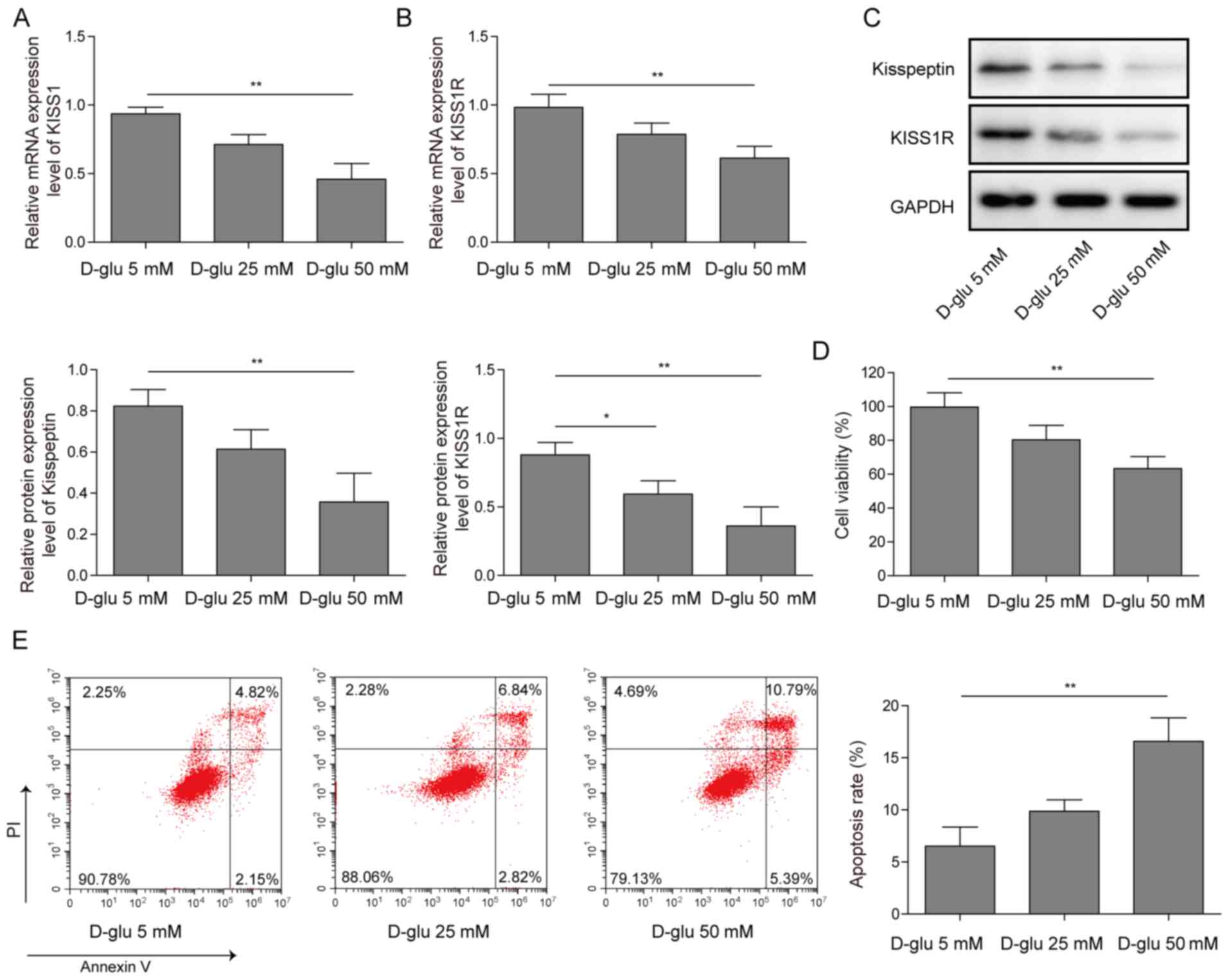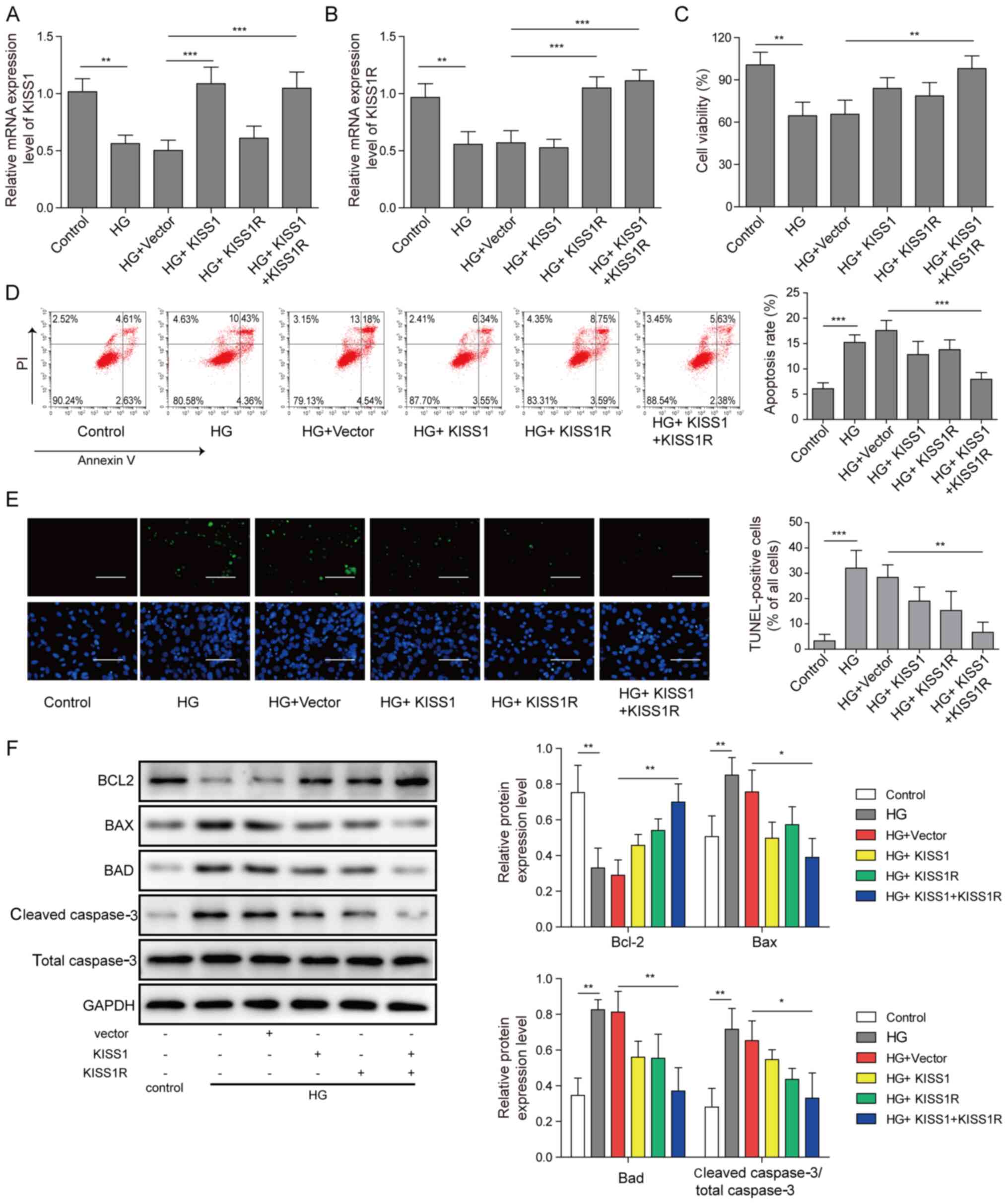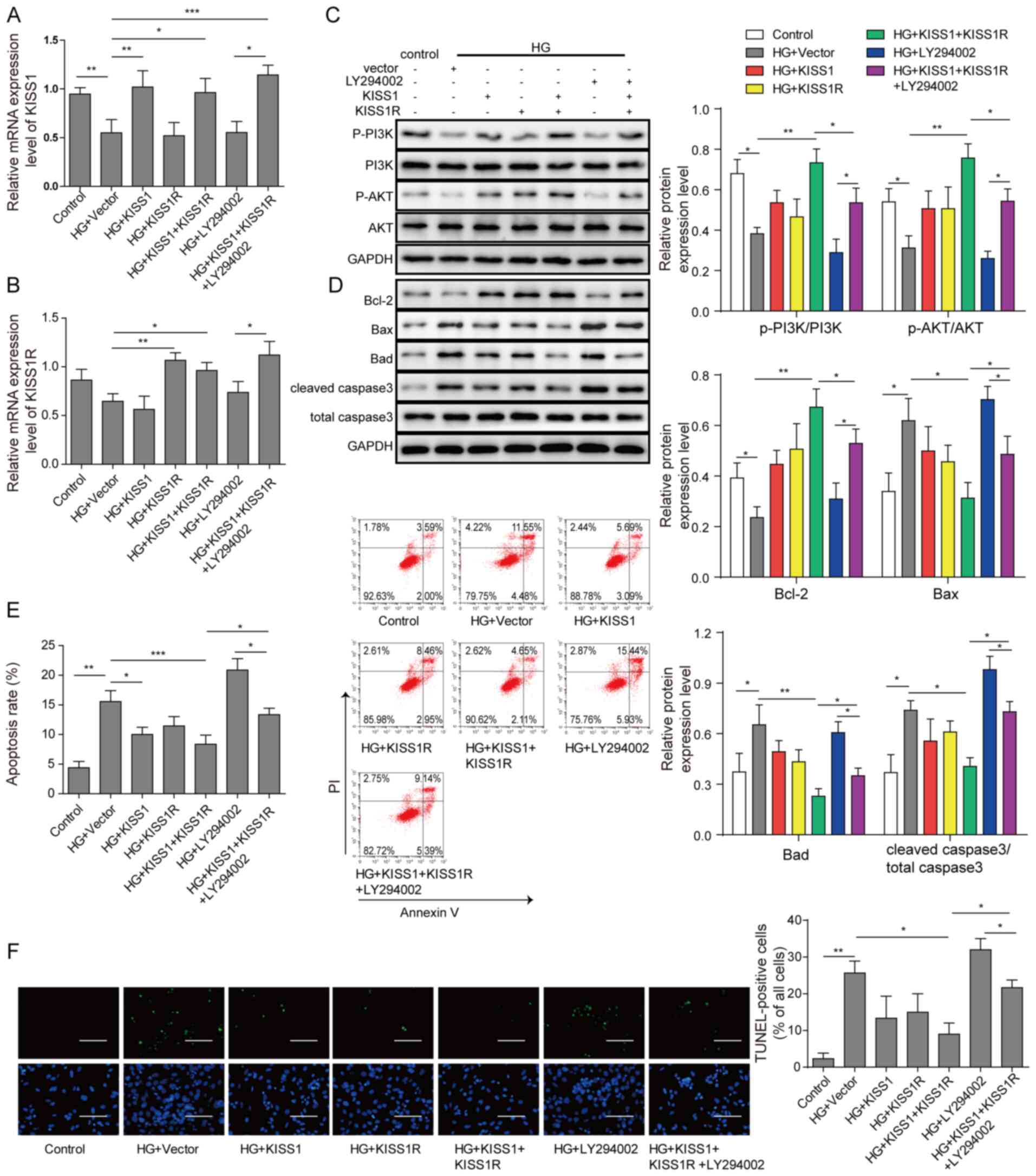|
1
|
Chen L, Magliano DJ and Zimmet PZ: The
worldwide epidemiology of type 2 diabetes mellitus-present and
future perspectives. Nat Rev Endocrinol. 8:228–236. 2011.
View Article : Google Scholar : PubMed/NCBI
|
|
2
|
Zheng Y, Ley SH and Hu FB: Global
aetiology and epidemiology of type 2 diabetes mellitus and its
complications. Nat Rev Endocrinol. 14:88–98. 2018. View Article : Google Scholar : PubMed/NCBI
|
|
3
|
Nathan DM: Long-term complications of
diabetes mellitus. N Engl J Med. 328:1676–1685. 1993. View Article : Google Scholar : PubMed/NCBI
|
|
4
|
Kyathanahalli C, Bangalore S,
Hanumanthappa K and Muralidhara: Experimental diabetes-induced
testicular damage in prepubertal rats. J Diabetes. 6:48–59. 2014.
View Article : Google Scholar : PubMed/NCBI
|
|
5
|
Maresch CC, Stute DC, Alves MG, Oliveira
PF, de Kretser DM and Linn T: Diabetes-induced hyperglycemia
impairs male reproductive function: A systematic review. Hum Reprod
Update. 24:86–105. 2018. View Article : Google Scholar : PubMed/NCBI
|
|
6
|
Jangir RN and Jain GC: Diabetes mellitus
induced impairment of male reproductive functions: A review. Curr
Diabetes Rev. 10:147–157. 2014. View Article : Google Scholar : PubMed/NCBI
|
|
7
|
Frenkel GP, Homonnai Z, Drasnin N, Sofer
A, Kaplan R and Kraicer PF: Fertility of the
streptozotocin-diabetic male rat. Andrologia. 10:127–136. 1978.
View Article : Google Scholar : PubMed/NCBI
|
|
8
|
Kühn-Velten N, Waldenburger D and Staib W:
Evaluation of steroid biosynthetic lesions in isolated leydig cells
from the testes of streptozotocin-diabetic rats. Diabetologia.
23:529–533. 1982. View Article : Google Scholar
|
|
9
|
Amaral S, Moreno AJ, Santos MS, Seiça R
and Ramalho-Santos J: Effects of hyperglycemia on sperm and
testicular cells of Goto-Kakizaki and streptozotocin-treated rat
models for diabetes. Theriogenology. 66:2056–2067. 2006. View Article : Google Scholar : PubMed/NCBI
|
|
10
|
Shukla KK, Mahdi AA, Ahmad MK, Shankhwar
SN, Rajender S and Jaiswar SP: Mucuna pruriens improves male
fertility by its action on the hypothalamus-pituitary-gonadal axis.
Fertil Steril. 92:1934–1940. 2009. View Article : Google Scholar : PubMed/NCBI
|
|
11
|
Li ZM, Liu N, Jiang YP, Yang JM, Zheng J,
Sun M, Li YX, Sun T, Wu J and Yu JQ: Vitexin alleviates
streptozotocin-induced sexual dysfunction and fertility impairments
in male mice via modulating the hypothalamus-pituitary-gonadal
axis. Chem Biological Interact. 297:119–129. 2019. View Article : Google Scholar : PubMed/NCBI
|
|
12
|
Fink G: Neuroendocrine regulation of
pituitary function. Neuroendocrinology in Physiology and Medicine.
Conn PM and Freeman ME: Humana Press; Totowa, NJ: https://doi.org/10.1007/978-1-59259-707-9_7
|
|
13
|
Caraty A, Franceschini I and Hoffman GE:
Kisspeptin and the preovulatory gonadotrophin-releasing
hormone/luteinising hormone surge in the ewe: Basic aspects and
potential applications in the control of ovulation. J
Neuroendocrinol. 22:710–715. 2010.PubMed/NCBI
|
|
14
|
Dhillo WS, Chaudhri OB, Thompson EL,
Murphy KG, Patterson M, Ramachandran R, Nijher GK, Amber V,
Kokkinos A, Donaldson M, et al: Kisspeptin-54 stimulates
gonadotropin release most potently during the preovulatory phase of
the menstrual cycle in women. J Clin Endocrinol Metab.
92:3958–3966. 2007. View Article : Google Scholar : PubMed/NCBI
|
|
15
|
Hu KL, Zhao H, Min Z, He Y, Li T, Zhen X,
Ren Y, Chang HM, Yu Y and Li R: Increased expression of KISS1 and
KISS1 receptor in human granulosa lutein cells-potential
pathogenesis of polycystic ovary syndrome. Reprod Sci.
26:1429–1438. 2019. View Article : Google Scholar : PubMed/NCBI
|
|
16
|
Hu KL, Zhao H, Chang HM, Yu Y and Qiao J:
Kisspeptin/kisspeptin receptor system in the ovary. Front
Endocrinol (Lausanne). 8:3652018. View Article : Google Scholar : PubMed/NCBI
|
|
17
|
Yu H, Liu J, Han Y, Chen C and Meng F:
Correlation between serum Kisspeptin and spermatogenic function in
men. bioRxiv. Oct 18–2019.doi: https://doi.org/10.1101/810572.
|
|
18
|
Funes S, Hedrick JA, Vassileva G,
Markowitz L, Abbondanzo S, Golovko A, Yang S, Monsma FJ and
Gustafson EL: The KiSS-1 receptor GPR54 is essential for the
development of the murine reproductive system. Biochem Biophys Res
Commun. 312:1357–1363. 2003. View Article : Google Scholar : PubMed/NCBI
|
|
19
|
Franke TF: PI3K/Akt: Getting it right
matters. Oncogene. 27:6473–6488. 2008. View Article : Google Scholar : PubMed/NCBI
|
|
20
|
Foster FM, Traer CJ, Abraham SM and Fry
MJ: The phosphoinositide (PI) 3-kinase family. J Cell Sci.
116:3037–3040. 2003. View Article : Google Scholar : PubMed/NCBI
|
|
21
|
Lin A, Piao H, Zhuang L, Sarbassov dos D,
Ma L and Gan B: FoxO transcription factors promote AKT Ser473
phosphorylation and renal tumor growth in response to pharmacologic
inhibition of the PI3K-AKT pathway. Cancer Res. 74:1682–1693. 2014.
View Article : Google Scholar : PubMed/NCBI
|
|
22
|
Beymer M, Negrón AL, Yu G, Wu S, Mayer C,
Lin RZ, Boehm U and Acosta-Martínez M: Kisspeptin cell-specific
PI3K signaling regulates hypothalamic kisspeptin expression and
participates in the regulation of female fertility. Am J Physiol
Endocrinol Metab. 307:E969–E982. 2014. View Article : Google Scholar : PubMed/NCBI
|
|
23
|
Chen S, Chen W, Zhang X, Lin S and Chen Z:
Overexpression of KiSS-1 reduces colorectal cancer cell invasion by
downregulating MMP-9 via blocking PI3K/Akt/NF-κB signal pathway.
Int J Oncol. 48:1391–1398. 2016. View Article : Google Scholar : PubMed/NCBI
|
|
24
|
Xin X, Li Z, Zhong Y, Li Q, Wang J, Zhang
H, Yuan X, Li J and Zhang Z: KISS1 suppresses apoptosis and
stimulates the synthesis of E2 in porcine ovarian Granulosa cells.
Animals (Basel). 9:542019. View Article : Google Scholar : PubMed/NCBI
|
|
25
|
Livak KJ and Schmittgen TD: Analysis of
relative gene expression data using real-time quantitative PCR and
the 2(-Delta Delta C(T)) method. Methods. 25:402–408. 2001.
View Article : Google Scholar : PubMed/NCBI
|
|
26
|
Dowarah J and Singh VP: Anti-diabetic
drugs recent approaches and advancements. Bioorg Med Chem.
28:1152632020. View Article : Google Scholar : PubMed/NCBI
|
|
27
|
Birben E, Sahiner UM, Sackesen C, Erzurum
S and Kalayci O: Oxidative stress and antioxidant defense. World
Allergy Organ J. 5:9–19. 2012. View Article : Google Scholar : PubMed/NCBI
|
|
28
|
Adedara IA, Okpara ES, Busari EO, Omole O,
Owumi SE and Farombi EO: Dietary protocatechuic acid abrogates male
reproductive dysfunction in streptozotocin-induced diabetic rats
via suppression of oxidative damage, inflammation and caspase-3
activity. Eur J Pharmacol. 849:30–42. 2019. View Article : Google Scholar : PubMed/NCBI
|
|
29
|
Johnson A, Cheng SC, Tsou D and Kong ZL:
Attenuation of reproductive dysfunction in diabetic male rats with
timber cultured Antrodia cinnamomea ethanol extract. Biomed
Pharmacother. 112:1086842019. View Article : Google Scholar : PubMed/NCBI
|
|
30
|
Jiang YP, Ye RJ, Yang JM, Liu N, Zhang WJ,
Ma L, Sun T, Niu JG, Zheng P and Yu JQ: Protective effects of
Salidroside on spermatogenesis in streptozotocin induced type-1
diabetic male mice by inhibiting oxidative stress mediated
blood-testis barrier damage. Chem Biol Interact. 315:1088692020.
View Article : Google Scholar : PubMed/NCBI
|
|
31
|
Liu J, Wang Y, Gong L and Sun C: Oxidation
of glyceraldehyde- 3-phosphate dehydrogenase decreases sperm
motility in diabetes mellitus. Biochem Biophys Res Commun.
465:245–248. 2015. View Article : Google Scholar : PubMed/NCBI
|
|
32
|
Luo D, Zhang M, Su X, Liu L, Zhou X, Zhang
X, Zheng D, Yu C and Guan Q: High fat diet impairs spermatogenesis
by regulating glucose and lipid metabolism in Sertoli cells. Life
Sci. 257:1180282020. View Article : Google Scholar : PubMed/NCBI
|
|
33
|
Gahete MD, Vázquez-Borrego MC,
Martínez-Fuentes AJ, Tena-Sempere M, Castaño JP and Luque RM: Role
of the Kiss1/Kiss1r system in the regulation of pituitary cell
function. Mol Cell Endocrinol. 438:100–106. 2016. View Article : Google Scholar : PubMed/NCBI
|
|
34
|
Ke R, Ma X and Lee LTO: Understanding the
functions of kisspeptin and kisspeptin receptor (Kiss1R) from
clinical case studies. Peptides. 120:1700192019. View Article : Google Scholar : PubMed/NCBI
|
|
35
|
George JT, Millar RP and Anderson RA:
Hypothesis: Kisspeptin mediates male hypogonadism in obesity and
type 2 diabetes. Neuroendocrinology. 91:302–307. 2010. View Article : Google Scholar : PubMed/NCBI
|
|
36
|
Li X, Zhu Y, Zhang C, Liu J, Zhou G, Jing
L, Shi Z, Sun Z and Zhou X: BDE-209 induces male reproductive
toxicity via cell cycle arrest and apoptosis mediated by DNA damage
response signaling pathways. Environ Pollut. 255:1130972019.
View Article : Google Scholar : PubMed/NCBI
|
|
37
|
Khodamoradi K, Amini-Khoei H,
Khosravizadeh Z, Hosseini SR, Dehpour AR and Hassanzadeh G:
Oxidative stress, inflammatory reactions and apoptosis mediated the
negative effect of chronic stress induced by maternal separation on
the reproductive system in male mice. Reprod Biol. 19:340–348.
2019. View Article : Google Scholar : PubMed/NCBI
|
|
38
|
Chen Z, Wen D, Wang F, Wang C and Yang L:
Curcumin protects against palmitic acid-induced apoptosis via the
inhibition of endoplasmic reticulum stress in testicular Leydig
cells. Reprod Biol Endocrinol. 17:712019. View Article : Google Scholar : PubMed/NCBI
|
|
39
|
Yang L, Lei L, Zhao Q, Gong Y, Guan G and
Huang S: C-Type natriuretic peptide/natriuretic peptide receptor 2
is involved in cell proliferation and testosterone production in
mouse leydig cells. World J Mens Health. 37:186–198. 2019.
View Article : Google Scholar : PubMed/NCBI
|
|
40
|
Ma Y, Qin H and Cui Y: MiR-34a targets
GAS1 to promote cell proliferation and inhibit apoptosis in
papillary thyroid carcinoma via PI3K/Akt/Bad pathway. Biochem
Biophys Res Commun. 44:958–963. 2013. View Article : Google Scholar : PubMed/NCBI
|
|
41
|
Zhang XH, Chen SY, Tang L, Shen YZ, Luo L,
Xu CW, Liu Q and Li D: Myricetin induces apoptosis in HepG2 cells
through Akt/p70S6K/bad signaling and mitochondrial apoptotic
pathway. Anticancer Agents Med Chem. 13:1575–1581. 2013. View Article : Google Scholar : PubMed/NCBI
|
|
42
|
Maiorino MI, Bellastella G and Esposito K:
Diabetes and sexual dysfunction: Current perspectives. Diabetes
Metab Syndr Obes. 7:95–105. 2014.PubMed/NCBI
|













